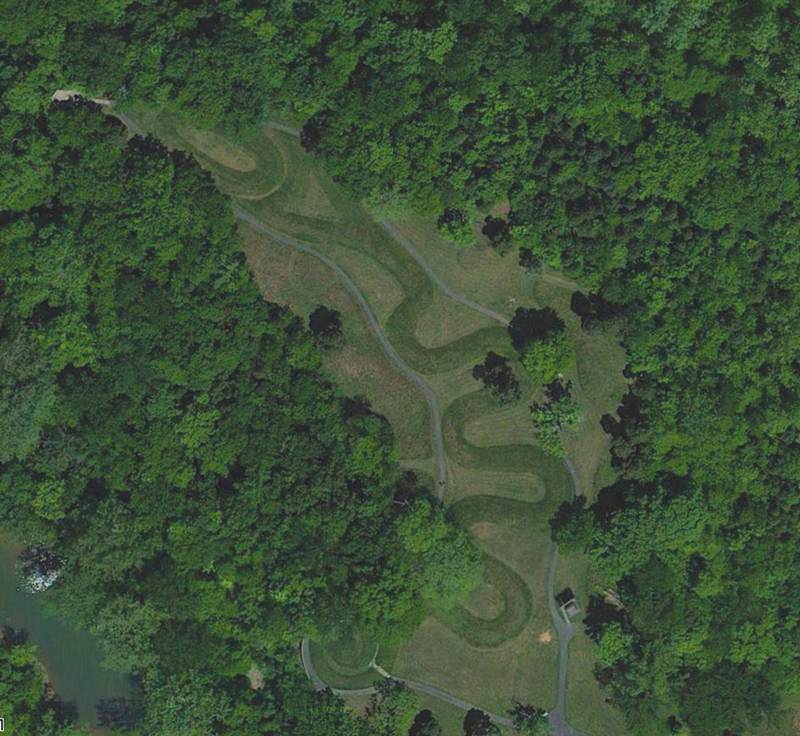Two-hundred-fifty-million years ago an estimated billion-ton meteor struck what is now southwestern Ohio and thus the groundwork was laid for the Serpent Mound, the largest effigy mound in the world. The “Serpent” is just two counties to the east from downtown Cincinnati, and contemplating what rural Ohio looked like hundreds-of-millions of years ago is a mind-bending task, but stranger than fiction is the controversy shadowing the Serpent Mound in 2013.
The mound, located in the hard-scrabble town of Peebles in Adams County, was built on a cliff’s edge above a twisting river and lush forest. The Serpent undulates and curls for roughly a quarter-mile, and the snake’s head appears to be devouring an egg, while others say the snake is swallowing the sun. Some believe the Serpent is a solar and lunar calendar of sorts, saying the head and the bending coils accurately mark all solstices and equinoxes.
Making the riddle of the Serpent even more complex is the fact the mound was built in the southwestern portion of a meteorite impact crater that is roughly five miles wide — a crater itself alien to the rest of rural Ohio considering the meteorite upturned layers upon layers of rock and earth.
The mound and its property are owned by the Ohio Historical Society, but the Shawnee and other Native American tribes claim “stewardship” of the Serpent. The Shawnee say because their ancestors built the effigy it is their responsibility to protect the Serpent and its heritage; ancestors who lived in the Ohio forests for thousands of years until the Indian Removal Act of the 1830s forced them to walk to Oklahoma in the middle of winter, killing many.
At the moment, two mainstream theories about who built the Serpent have taken the lead: that the Adena culture built the mound sometime between 800 BC and 100 AD; or, as more recent evidence suggests, that the mound is much younger — built by the Fort Ancient culture between 1000 AD and 1650 AD.
But those who dismiss the mainstream theories believe the mound could be 5,000 years or older and built for reasons that are literally not of this world.
And this is perhaps the Serpent’s greatest mystery: Exactly why was the mound built? What is its purpose?
The Serpent’s great debate continues as it challenges a colorful group of experts that include archeologists, geologists, anthropologists, astrologists, paleontologists, fringe scientists, and “archaeoastronomists.”
And the quest to answer the Serpent Mound mystery has sparked a present day stand-off between Native Americans and “New Agers” — adherents to a spiritual thought system that borrows elements of several theologies but tends to admonish any “moral absolutes” and thrives on mysticism and the virtues of peace — answers that, at the moment, seem as reachable as a shovel is to dirt, or as far-off as a meteorite streaking across the Milky Way.
The Native Americans, led mainly by a group of Shawnee from Oklahoma, claim the Serpent is a sacred site akin to Jerusalem’s Wailing Wall or the Great Pyramids of Giza and that any suggestion Native Americans did not build the mound or constructed it for purposes other than helping their own culture is simply unacceptable. The Shawnee from Oklahoma are dead serious, as they are still bitter about how more than 100 years ago Harvard University dug up Native American skeletons buried near the Serpent and took them back East and then lost the remains.
“The Serpent Mound and the other mounds we left in Ohio are sacred. The Serpent Mound and other Native American earthworks don’t seem to get the respect the Pyramids receive and that bothers me,” says Eastern Shawnee Tribe of Oklahoma Chief Glenna J. Wallace, who has traveled the globe as a college administrator and researcher. “The United States as a whole just doesn’t seem to be as dedicated as preserving Native American history or stopping these acts of vandalism. In foreign countries [at their sacred sites] they preserve and respect them — they don’t loot and dig them up and take their dead away.”
The Shawnee may scoff, but New Agers also revere the site as sacred. Some New Agers say you can tangibly feel the Serpent’s “energies.” Other more extreme New Age views, for instance, believe the Serpent may someday be “reactivated” and become a portal to another world. Several sources say the New Agers’ infatuation with Serpent took hold in the late 1980s following an event referred to as the Harmonic Convergence, a worldwide celebration of “synchronized meditation.” More reserved New Age ceremonies of late have attracted hundreds, particularly during the summer and winter solstices.
The controversy is literally one for the ages, as some Native Americans have labeled the New Agers the “white nerds” who, like past white men, are stealing their land. But adding insult to injury, these white men are also co-opting their culture and heritage. Some Shawnee even suggest New Age leaders are using the Serpent as a recruiting tool and money maker.
The Shawnee’s anger — and mockery, for that matter — reached a crescendo in 2011, said a source close to the Oklahoma Shawnee, when the History Channel’s Ancient Aliens suggested the Serpent was a land-based beacon for extraterrestrials thousands of years ago. The theory goes on to suggest extraterrestrials were seeking to mine the rare element iridium, which can be found in meteorites and is in the Serpent’s crater, but only in minute amounts.
The New Age fans of the Serpent, on the other hand, say the Shawnee are “overreacting.” Several sources who live within walking distance of the Serpent and work for Friends of the Serpent Mound, a nonprofit that promotes the mound, say it’s true that thousands of New Agers consider the Serpent a Mecca of sorts. And these sources also admit, wholeheartedly, that a small “cultish” faction of New Agers in 2012 did desecrate the Serpent by digging into it.
Most “New Age” fans of the Serpent, however, are not “card-carrying” New Agers, say Friends of the Serpent Mound, but right-sided, left-leaning “artistic types” whose life-lessons are influenced by Native American traditions, such as promoting peace and venerating nature.
No matter how serious the controversy, it brings attention to what is arguably Ohio’s greatest landmark, one that in the middle of last century attracted more than 100,000 tourists a year from all corners of the planet. Unfortunately, during the last 30 years or so, the Serpent has registered just over 20,000 visitors annually, say Friends of the Serpent Mound, which has also logged thousands of hours protecting it. But the Serpent’s popularity may again be gaining traction: The Serpent was recently named by National Geographic as one of the four “Sacred Places of the World” and is also a U.S. nominee to the UNESCO World Heritage sites.
Native American and Cincinnati resident Mary Annette Pember writes for IndianCountryTodayMediaNetwork.com and has previously worked as a Cincinnati Enquirer reporter. She is a member of the Ojibwe tribe from Wisconsin and this summer she published a scathing piece on the nonprofit Friends of the Serpent Mound. Her targets also include the Ohio Historical Society, which grants permission to groups seeking ceremonies at the mound, and the Serpent’s on-site caretakers, a group called Arc of the Appalachia.
Pember’s article detailed a long list of New Age ceremonies the caretakers have allowed during the last three years. Two separate New Age events especially “stick in her craw,” she says. The first was a Mayan-related event in October of 2011, and the second was a visit a year later by members of Unite the Collective, what some have described as a cult.
The Mayan event was special to New Agers because world-renowned “Mayan elder” Hunbatz Men spent the day using crystal skulls seeking to awaken the Serpent’s spiritual energies. Some New Agers believe there are 13 crystal skulls, made of clear quartz, that are pre-Columbian “ancient computers,” and if unlocked can answer humanity’s most significant riddles. Apparently the 13 crystal skulls were at the mound that day, but thousands of crystal skulls are now in circulation. And, what’s more, the 13 crystal skulls believed to be “ancient computers” were deemed a fraud by many mainstream scientists over the last 10 years.
Nonetheless, Men, who according to Newagefraud.com may not even be Mayan, allegedly “spoke” to several crystal skulls that day as he was surrounded by dozens of New Agers.
The Friends of the Serpent Mound say they weren’t made fully aware what the Mayan event was all about. It was a peaceful ceremony, nonetheless, and a rainbow even appeared over the Serpent after a brief sun shower fell during one of Men’s rituals. But Friends of the Serpent Mound admit it was the Unite the Collective event that literally left a scar on the Serpent.
Unite the Collective, a youth-dominated, nonsensical, Scientology-like group who call themselves “light warriors,” allegedly buried an unknown number (perhaps dozens) of “orgonites” in the Serpent hoping to “reactivate it.” Orgonites, a combination of resin, metal shavings and a piece of quartz poured into a muffin tin and then hardened, are believed by New Agers to detect and measure “life energy” or “chi.” For a time they were sold at the mound’s onsite museum run by Arc of the Appalachia, but have since been removed.
“You start researching these people and you can’t make this shit up,” Pember says, dryly. “This is emblematic of this New Age stuff. It’s like the final co-opt; the final colonization, if you will, of the native people. They took the land, but it’s not enough. Now they have to co-opt our spirituality. It’s a Walmart mentality towards native people’s spirituality.”
Pember’s online article was followed by an onslaught of readers’ comments seething with anger toward Friends of the Serpent Mound, which was founded in 2004. Back then, Friends of the Serpent Mound (FOSM) was given a green light to promote the effigy and help coordinate events by both the Ohio Historical Society and the Adams County’s Chamber of Commerce and Travelers and Visitors Bureau. Some Shawnee have suggested that because Adams County’s economy has been depressed for many years, like many Ohio rural counties, the FOSM is heavily targeting New Agers seeking their untapped tourist dollars.
FOSM president Delsay Wilson, who lives near the mound, says, “A lot of people think Friends of the Serpent Mound is all about New Age but it’s not. We are not pushing a New Age agenda. We’re not New Age.”
With that said, adds Wilson, New Agers and anyone else, for that matter, have every right to honor and even worship the mound as they wish as long as they don’t walk on the mound or desecrate the mound. These are the rules for one simple reason — the Serpent is a public space.
“Everybody does what they feel they want to bring to it; it’s an awesome community,” she says about those who regularly attend the annual winter and summer solstice events.
During the winter solstice celebration, says Wilson, more than 600 candles illuminate the outline of the Serpent and candles are placed in the center of the egg (or sun), as well. “A handful of people are picked to walk across the mound and it’s done in a respectful way. Word spread because we took pictures and it was gorgeous.”
“I think when people come to these activities it’s not this bizarre, New Age activity,” she adds. “It’s a way of honoring the ancients and the site itself. There are Native Americans and New Agers who are together and stand together in their reverence of the mound.”
Cincinnati resident and Serpent Mound historian Ross Hamilton is also a member of Friends of the Serpent Mound. He’s written several controversial books about the Serpent, including The Mystery of the Serpent Mound, which postulates the mound could be 5,000 years or older and that untold layers of mysteries are awaiting to solved.
Hamilton’s books are sold at the Serpent’s onsite museum run by the Arc of Appalachia. The books are a point of contention with the Oklahoma Shawnee, who believe Hamilton has warped Native American mythology into a pseudo-science that is not genuine.
Hamilton, who says he is deeply respectful to Native American history, says no one can deny the power of the Serpent.
“The Serpent Mound has amazing energy. It is the only site in Ohio that can make your arm hair stand on end under the right conditions,” he says. “Some people who spend time there have a catharsis. They cry and weep. People find that their prayers are answered. They have moments of clarity and enlightenment. There’s just a general feeling of elation, especially when the seasons change.”
He adds, “A bug has been put in their ear that New Agers are digging into the earthworks with staffs that have crystals on the end and they’re wearing Native wear.”
“If the Shawnee traditionalists would open their hearts and minds and understand that these New Agers love them and what their ancestors did, they might eventually be softened,” says Hamilton, who personally believes the Serpent is a centrally located “star lodge” surrounded by other “star mounds” in the Ohio Valley.
Both Hamilton and Wilson strongly condemn Unite the Collective and say digging holes into the mound was a game-changer for the Serpent’s local caretakers.
“By no means are we for people digging in the mound,” Wilson says. “We do not approve and we will stop people from doing this. This is what we are all about: preserve and protect. We’ve turned people in before (to local county Sheriff’s office).”
Chief Wallace of the Oklahoma Shawnee says, “The New Age reverence does have that same solemnity native peoples bring to it. We certainly would not be sneaking onto the mound in the middle of the night digging holes into it. We hope their (Friends of the Serpent Mound) purpose is noble.”
Chief Wallace says it is OK to have an individual perspective of the Serpent mound’s purpose, but the Shawnee want the individual to know the Serpent was built by their ancestors and that its purpose is based on realistic Native American culture alone. She personally believes the mound may have been constructed by a native “snake clan” that once lived in the region.
On a warm and breezy yet overcast day this past September, the owner of a museum and gift shop located within the Serpent Mound impact crater took this reporter to the top of a nearby bald hill that is also home to a cemetery crammed with aging and weathered headstones. The quirky museum is the House of Phacops Rock Shop — named after an extinct marine arthropod — and the museum focuses more on geology and paleontology (the crater) than the mound (archeology and anthropology).
The owner is Tom Johnson, and from the vantage point of the cemetery on top of the bald hill, which gives you a 360-degree view of the impact crater, Johnson offered a legitimate reason to why New Agers are so attracted to the Serpent.
The House of Phacops sits on the top of a miles-deep 17.5-km long fault line, or a fracture in the earth’s crust where earthquakes originate. Johnson believes the Serpent Mound impact crater is the only place on earth where a meteor struck a deep-seated fault line and blasted hole through it.
“It tore a hole through the crust of the earth and energy comes through it,” he said.
This is the reason magnetic anomalies are common throughout the Serpent Mound impact crater, Johnson says.
“You have to live here awhile to witness this stuff, but certain areas of the crater will discharge car batteries,” he says. “Even American Electric Power takes into account these anomalies.”
He adds, “When New Agers talk about ‘they feel energies coming from the Serpent Mound,’ it’s because of the fault line.”
The owner’s of the Serpent, the Ohio Historical Society (OHS) based in Columbus, are now keeping a close eye on the New Age ceremonies taking place at the mound, especially following the crystal skull event and the Unite the Collective disaster.
OHS did indeed approve these events, but they did not endorse them as being authentic to the Serpent and its heritage, as stated by OHS’s most public figure, Brad Lepper, on the society’s website. The OHS also told CityBeat that “they’ve learned from the past,” and while they cannot deny Unite the Collective from ever having future ceremonies at the public site, they have promised to put a much greater effort in making such groups comply with park rules.
Chief Wallace says she does not condemn OHS for this, considering OHS is funded in part by Ohio taxpayer dollars and thus beholden to the state’s public.
What has impressed her is how following the controversial New Age events the OHS has reached out to the Shawnee and other tribes seeking guidance on how to honor the mound. This past summer two busloads of Shawnee on a cultural tour were invited to the OHS office in Columbus to air grievances and teach the Serpent’s caretakers that Native American heritage is not to be trivialized.
“We have educated them quite a bit,” says Chief Wallace about OHS, and the two groups are working on educational programs for the public.
Nevertheless, Lepper told CityBeat, as for why the Serpent was built, “I don’t think we can make a claim one way or the other.” It could have been for spiritual purposes or for agrarian reasons, or both, he says.
“The fact that it could be used as a calendar doesn’t mean that was its primary purpose,” says Lepper, who has suggested the mound could be a shrine to the Native spiritual power “Mishebeshu,” which is the Ojibwe name for “The Great Serpent.”
Nevertheless, he understands why some people have epiphany-type reactions when they visit the Serpent Mound.
“I am taking my science hat off here, but I do feel a special power of that site,” he says. “It’s not any sort of energy that you could ever detect with any sort of energy meter, it’s just a special place. When I’m there, more so than any of the other Native American sites, I feel like I am in a church. It feels as if you should speak in hushed tones, that sort of thing.” ©






